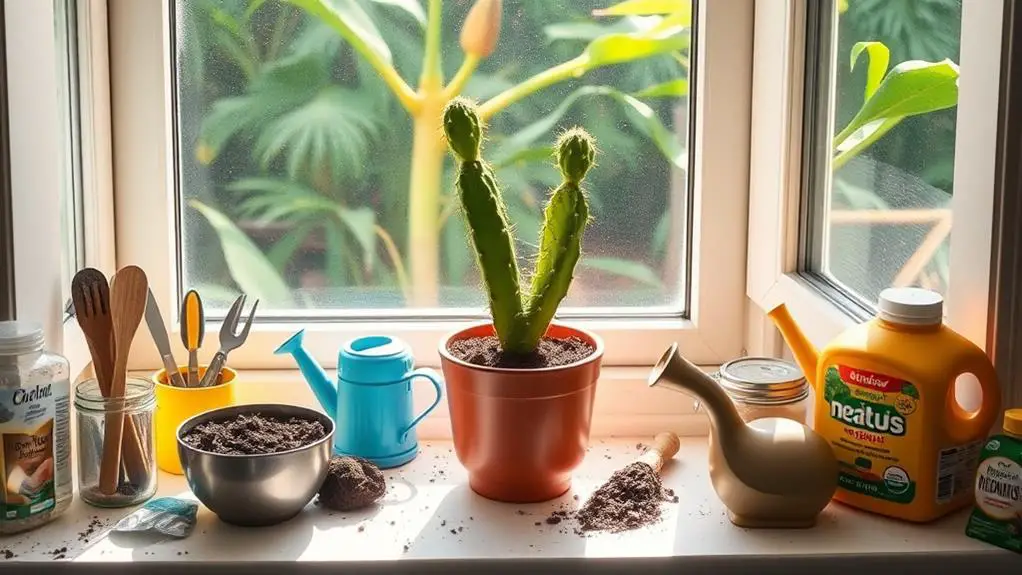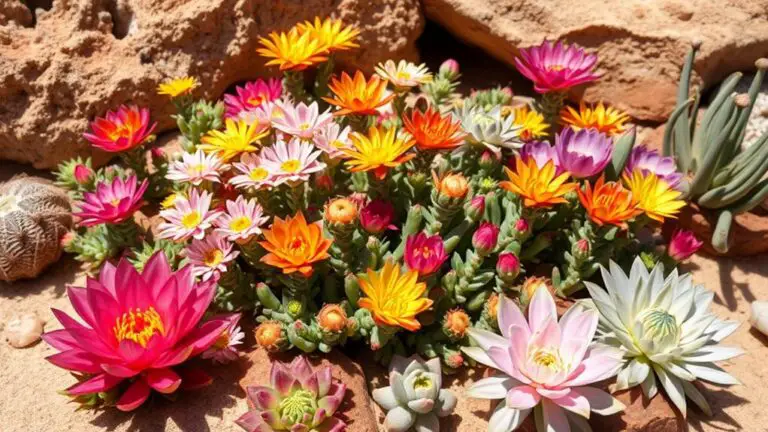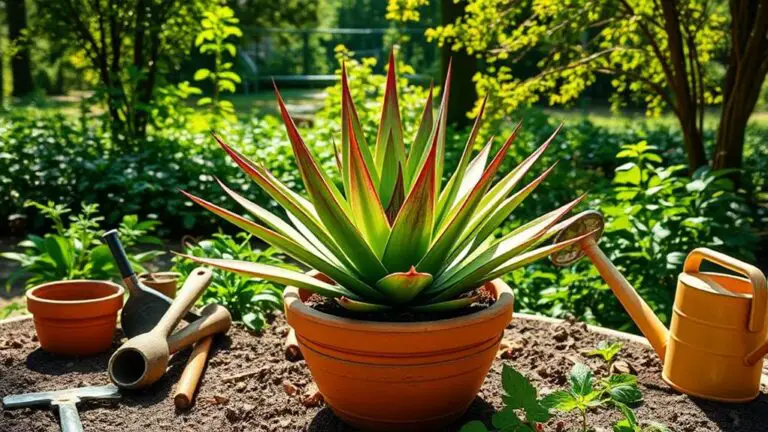Five Easy Steps to Grow a Dancing Bones Cactus
If you've ever wanted to successfully grow a Dancing Bones Cactus, you're in the right place. This unique plant, known for its whimsical appearance, requires just a few straightforward steps to thrive. You'll need to take into account ideal lighting, precise watering techniques, and the right soil mix, among other things. But what makes these steps so important, and how can you guarantee each one is executed perfectly? Stick around as we break down these five essential steps, making it easier than ever to nurture your Dancing Bones Cactus to its full potential.
Provide Optimal Lighting
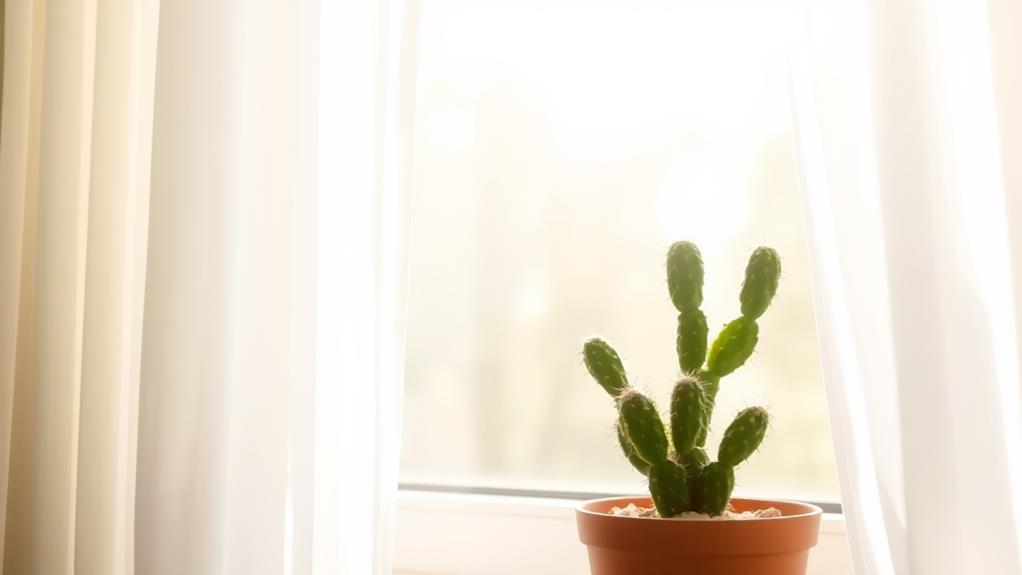
Guaranteeing your Dancing Bones Cactus thrives starts with providing perfect lighting. Position your cactus less than a foot away from a south-facing window. This spot offers the bright light necessary for the plant's best growth. However, direct afternoon sunlight can be too intense and may scorch its delicate stems. To protect it, use sheer curtains that allow filtered light to come through. This way, your cactus still gets enough light without the risk of damage.
Remember to adjust your cactus's location with the changing seasons. During spring and summer, when the cactus is actively growing, it will need more light. Moving it to a brighter spot can help it flourish during these months.
If your home doesn't get much natural light, especially in the winter, consider using grow lamps. These lamps can supplement light exposure and guarantee your cactus continues to grow well.
Make sure to place your cactus away from heating vents and air conditioning units. These can create temperature and humidity fluctuations that stress the plant.
Watering Techniques

While maintaining ideal lighting is key, understanding proper watering techniques is just as important for your Dancing Bones Cactus. To keep your cactus healthy, water it when the topsoil feels dry to the touch. It's vital to let the soil dry out completely between waterings to prevent root rot.
During spring and summer, you'll need to water more frequently since this is the plant's active growing season. As fall and winter approach, reduce watering since the cactus enters dormancy.
Using a well-draining soil mix is essential. Cactus and succulent mixes work best. This type of soil helps prevent excess moisture, which can lead to fungal growth and other problems.
Always make certain that your pot has good drainage holes, so water doesn't accumulate at the bottom.
Here are some quick tips to remember:
- Don't let your cactus sit in standing water; guarantee proper drainage.
- Adjust your watering schedule based on indoor humidity levels.
- Monitor the soil regularly to know when it's time to water again.
Soil and Fertilizer Needs
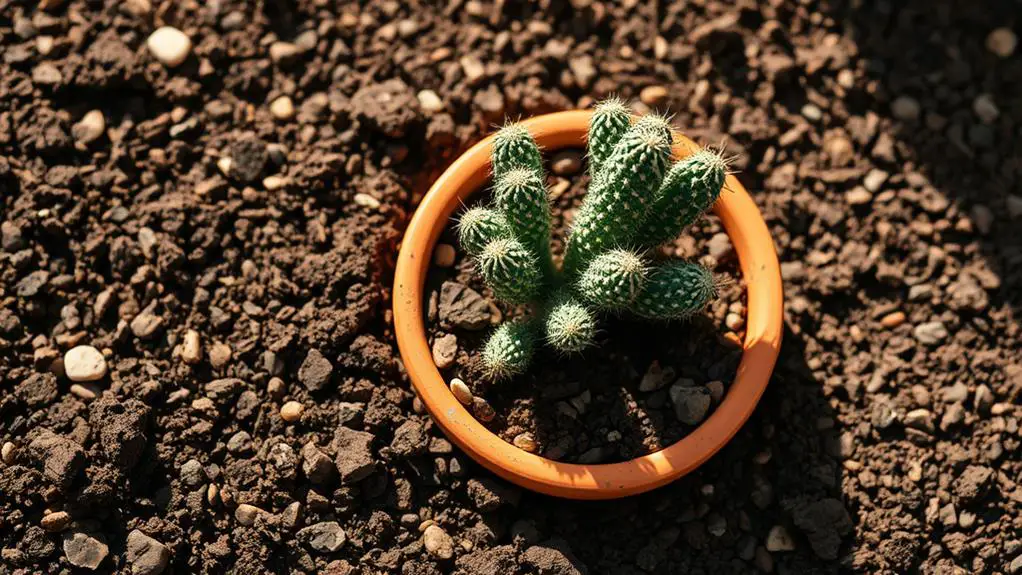
Choosing the right soil and applying the proper fertilizer are vital for a thriving Dancing Bones Cactus. Start with a well-draining, porous soil mix designed for cacti and succulents. You can create this mix using potting soil, perlite, sand, and peat.
This combination guarantees proper drainage, which is essential for your cactus's health. Avoid using dense or heavy soils, as they can retain too much moisture and lead to root rot.
Fertilizing your Dancing Bones Cactus is also significant. During the active growing season, typically spring and summer, use a balanced, water-soluble fertilizer. Dilute it to half-strength and apply it every 4-6 weeks.
This helps provide the necessary nutrients without overwhelming the plant. Be careful not to fertilize during the dormant season, which is fall and winter. Doing so can cause root burn and stress the cactus.
Repotting every 1-2 years is advantageous. Choose a pot that's about 10% larger than the previous one to give the roots more room to grow.
Fresh potting soil usually has enough nutrients to support initial growth, so you mightn't need to fertilize right away. Regularly check soil moisture to guarantee ideal conditions for your cactus.
Proper Potting Practices
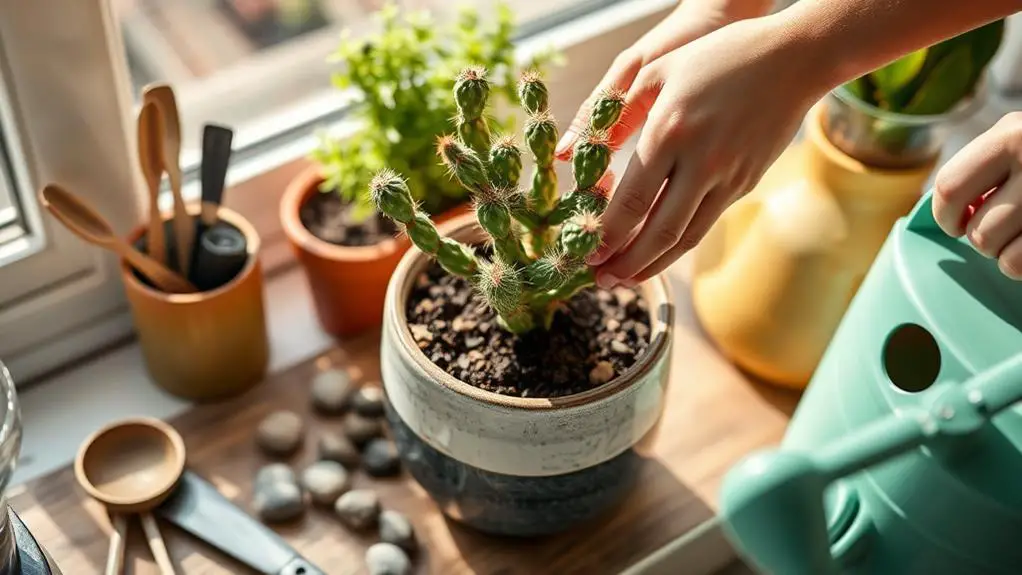
For proper potting practices, start with selecting a pot that has excellent drainage holes to prevent root rot. It's essential that excess water can escape easily, guaranteeing your Dancing Bones Cactus stays healthy.
Opt for pots made from porous materials like terracotta or clay. These materials help regulate moisture levels around the roots, which is vital for cacti.
Next, use a well-draining cactus potting soil mix. You can find mixes specifically designed for cacti and succulents. These typically contain sand, perlite, and peat, which create the perfect environment for your cactus. This mix guarantees that water doesn't linger too long, preventing root rot.
When repotting, choose a new pot that's about 10% larger than the previous one. This extra space allows for healthy root growth and gives your cactus room to thrive.
The best time to repot your Dancing Bones Cactus is during the active growing season in the spring. This timing helps the plant establish itself more easily.
- Choose a pot with good drainage.
- Use well-draining cactus potting soil.
- Repot during the spring growing season.
Following these steps guarantees your Dancing Bones Cactus gets the best start in its new home.
Effective Pest Management

A healthy Dancing Bones Cactus starts with effective pest management. To keep your cactus thriving, you'll need to regularly inspect it for common pests like mealybugs and spider mites. Early detection is vital, so make it a habit to check your plant often.
If you spot an infestation, don't panic. Treat the affected areas with insecticidal soap or neem oil. Just follow the product instructions to guarantee you get the best results. Neem oil is especially effective and natural, making it a great choice for your cactus care.
Before introducing new plants to your collection, quarantine them for at least two weeks. This step helps prevent new pests from spreading to your existing cacti.
Maintaining cleanliness around your plant is also key. Remove any debris or fallen leaves, as they can harbor pests and contribute to infestations. A clean environment helps keep your cactus pest-free.
Consider increasing the humidity levels around your cactus slightly. Many pests dislike humid conditions, and it can help keep your cactus healthy.
Frequently Asked Questions
How Do You Grow Cactus Step by Step?
To grow a cactus, pick a well-draining pot, provide bright, indirect light, water when the topsoil's dry, maintain a warm temperature, and fertilize during the growing season. Avoid overwatering and guarantee proper drainage to prevent root rot.
How Do You Grow Dancing Bones?
To grow a Dancing Bones Cactus, place it in bright, indirect light. Water only when the topsoil is dry. Use well-draining soil, fertilize during the growing season, and propagate with stem cuttings. Avoid harsh sunlight.
How Do You Start a Fishbone Cactus?
To start a Fishbone Cactus, cut a healthy stem segment and let the cut end callus for a day or two. Plant it in well-draining soil, water sparingly, and provide bright, indirect light for ideal growth.
What Is the Pattern of Growth of the Fishbone Cactus?
The fishbone cactus grows in a zigzag pattern with its flat, segmented stems. You'll notice it grows more actively in spring and summer, thriving in bright, indirect light and moderate humidity, making it a unique indoor plant.
Conclusion
You've got all the steps to grow a healthy Dancing Bones Cactus. Just place it in bright, filtered light, water when the soil's dry, and use well-draining soil. Don't forget to fertilize during the growing season and keep an eye out for pests. With these tips, you'll be well on your way to enjoying a thriving cactus. Remember, patience and attention are key. Happy gardening, and enjoy watching your cactus grow!

